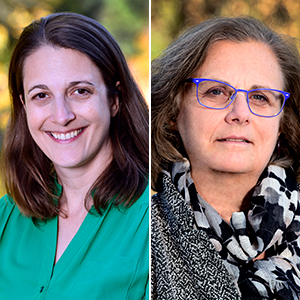“Given the high incidence of breast cancer and the widespread nature of environmental exposures, such as air pollution, our research has potential for substantial public health impact,” said Alexandra White, Ph.D., who leads the Environment and Cancer Epidemiology group at NIEHS.
 “Developing more accurate exposure models and applying them in much larger study populations is essential to the study of air pollutants and breast cancer risk,” said White. (Photo courtesy of Steve McCaw / NIEHS)
“Developing more accurate exposure models and applying them in much larger study populations is essential to the study of air pollutants and breast cancer risk,” said White. (Photo courtesy of Steve McCaw / NIEHS)Breast cancer accounts for 30% of newly diagnosed invasive cancers in women, reports the American Cancer Society. Furthermore, population-based data show significant, steady increases in breast cancer from 1935 to 2015, particularly among younger women (age 25–39 years).
The condition has known or suspected links to many environmental factors.
“Those factors need greater consideration as contributors to these higher rates,” said White. “There has not been significant progress in reducing breast cancer incidence with the risk factors that have been identified.”
The conundrum for scientists and health care practitioners is that even established risk factors, such as postmenopausal obesity and alcohol intake, have small effects on the overall chance of developing breast cancer.
“However, these modest effects do not necessarily translate to a lack of public health importance,” said White. “To better understand how the environment contributes to breast cancer risk, we need to understand how different environmental factors may work together. This will help us identify the key factors. Then, hopefully, we can make progress by reducing the most important exposures.”
 Research shows that in general, staying physically active, maintaining healthy weight, and eating a nutritious diet can reduce the chance of developing breast cancer. (Photo courtesy of rawpixel / Shutterstock.com)
Research shows that in general, staying physically active, maintaining healthy weight, and eating a nutritious diet can reduce the chance of developing breast cancer. (Photo courtesy of rawpixel / Shutterstock.com)Documenting effects from air pollution
Air pollution may be among those key exposures, according to recent research. Found worldwide, such pollution is a complex mixture of solid and liquid particles and gases.
In 2018, White co-authored a review article that identified 17 studies on the risk of breast cancer associated with air pollution. Nitrogen dioxide (NO2) and nitrogen oxides — both proxies for traffic-related air pollution — were linked to breast cancer.
Three years on, findings from an updated review showed that decreasing long-term NO2 exposure could lower breast cancer incidence.
The NIEHS Sister Study is a leading resource for research on environmental factors and breast cancer. In this study, White and her group found that women who live in areas of higher air pollution had a higher risk of developing breast cancer. Risk varied geographically due to different sources of pollution across the U.S. (See sidebar for more findings.)
Underlying consequences
“Among the many different compounds in air pollution, some act as endocrine disruptors and may affect hormonal pathways,” she said. “The scientific literature is pretty clear that endocrine disruption can affect breast cancer development.”
“We want to know whether exposure to certain endocrine-disrupting and carcinogenic chemicals in air pollution leads to an increased chance for breast cancer later in life,” noted White.
Because breast cancer can take a long time to develop, more recent exposures may not be the most relevant. Moreover, studies that only look at exposure to air pollution at a later point in life may not account for effects from earlier exposures.
Moving forward
White is interested in breast cancer studies that consider historical levels of exposure to pollutants. Her team plans to study how exposure to air pollution, especially during childbearing years, might be related to breast cancer risk decades later.
She noted that Black women need better representation in these studies.
Increasingly, her team will consider multiple exposure sources and interactions among different compounds over time. This approach will be applied in a project looking at residential exposure to industrial carcinogenic emissions and how certain types of emissions may act together to influence breast cancer risk.
White further explained goals of future research.
- Characterize air pollutant mixtures and their contributions to breast cancer risk.
- Explore racial and ethnic health disparities.
- Consider the effects of air pollutants throughout the life course, particularly early life.
These considerations could lead to greater insight on how air pollution affects breast cancer risk, according to White.
 Health disparities are part of the equation, according to White. Communities with the highest exposures to air and industrial pollutants tend to have more people of color. (Photo courtesy of pixelheadphoto digitalskillet / Shutterstock.com)
Health disparities are part of the equation, according to White. Communities with the highest exposures to air and industrial pollutants tend to have more people of color. (Photo courtesy of pixelheadphoto digitalskillet / Shutterstock.com)Solving problems
At NIEHS, White’s team seeks to identify exposures that can be reduced either with policy changes or actions that women can take on their own.
The concept of place-based health is important, according to White. Where people live may be critical to evaluating their risks for developing breast cancer, receiving adequate treatment, and estimating short- and long-term survival after a diagnosis.
“As an outcome of our work, I’d like to see more widespread acknowledgement that air pollution plays a role in breast cancer risk,” she said. “This recognition could influence policies related to acceptable air pollution exposure levels, which could help to reduce the incidence of breast cancer.”
Citations:
White AJ. 2021. Invited perspective: air pollution and breast cancer risk: current state of the evidence and next steps. Environ Health Perspect. 129(5):51302.
Gabet S, Lemarchand C, Guénel P, Slama R. 2021. Breast cancer risk in association with atmospheric pollution exposure: A meta-analysis of effect estimates followed by a health impact assessment. Environ Health Perspect. 129(5):57012.
Lima SM, Kehm RD, Swett K, Gonsalves L, Terry MB. 2020. Trends in parity and breast cancer incidence in US women younger than 40 years from 1935 to 2015. JAMA Netw Open. 2;3(3):e200929.
White AJ, Keller JP, Zhao S, Carroll R, Kaufman JD, Sandler DP. 2019. Air pollution, clustering of particulate matter components, and breast cancer in the Sister Study: a U.S.-wide cohort. Environ Health Perspect. 127(10):107002.
White AJ, Bradshaw PT, Hamra GB. 2018. Air pollution and breast cancer: a review. Curr Epidemiol Rep. 5(2):92–100.
(Carol Kelly is managing editor for the NIEHS Office of Communications and Public Liaison.)









